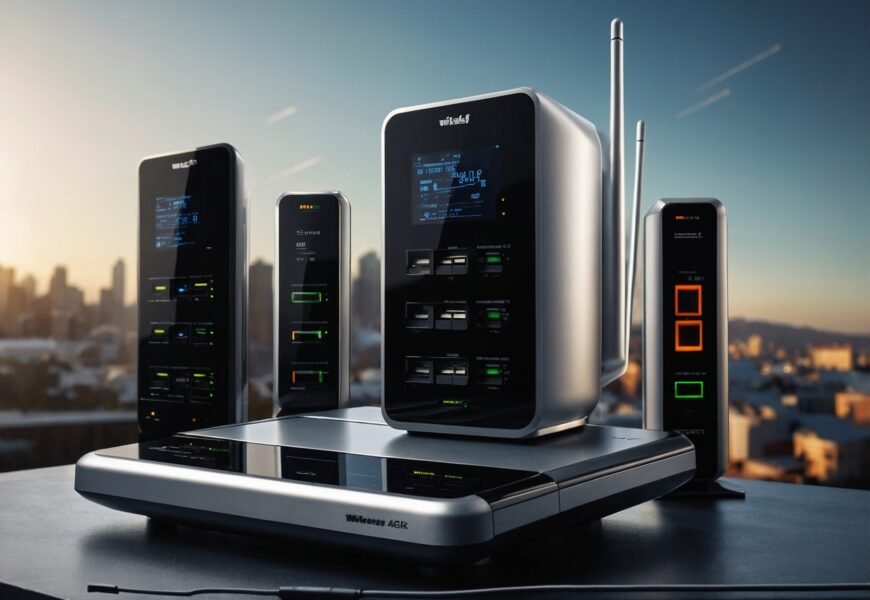In today’s hyper-connected world, wireless networking technologies have become the invisible threads that weave our digital lives together. From the Wi-Fi networks that power our homes and offices to the cellular networks that keep us connected on the go, these technologies have revolutionized the way we communicate, work, and live. As we step into 2024, the landscape of wireless networking is more exciting than ever, with new innovations promising to reshape our world in ways we’re only beginning to imagine.
Imagine a world where everything is connected seamlessly, from your smartphone to your smart home devices, and even entire cities! Welcome to the exciting realm of wireless networking technologies in 2024! Did you know that by 2024, it’s estimated that there will be over 14 billion mobile devices connected to the internet worldwide? That’s mind-blowing, isn’t it? In this article, we’ll take you on a journey through the evolution of wireless networking, from the humble beginnings of Wi-Fi to the lightning-fast speeds of 5G and beyond. Get ready to dive into the invisible web that’s revolutionizing the way we live, work, and play!
The Foundation: Understanding Wi-Fi
Wi-Fi, short for Wireless Fidelity, has been the backbone of our wireless internet connectivity since its invention in 1997. It allows devices to network through wireless access points, connecting with each other as well as with wired devices and the Internet. But what exactly is Wi-Fi, and how has it evolved over the years?
At its core, Wi-Fi is a technology that uses radio waves to provide high-speed internet and network connections. It operates on specific frequency bands, typically 2.4 GHz and 5 GHz, to transmit data between devices and access points. The beauty of Wi-Fi lies in its simplicity and accessibility – it allows us to connect multiple devices to the internet without the need for physical cables, providing flexibility and convenience in our increasingly mobile world.
Evolution of Wi-Fi Standards
Since its inception, Wi-Fi has gone through several iterations, each bringing improvements in speed, range, and efficiency. Let’s take a quick look at the evolution of Wi-Fi standards:
- 802.11b (1999): The first widely adopted Wi-Fi standard, offering speeds up to 11 Mbps.
- 802.11a (1999): Introduced alongside 802.11b, it operated on the 5 GHz band and offered speeds up to 54 Mbps.
- 802.11g (2003): Combined the best of ‘b’ and ‘a’, offering speeds up to 54 Mbps on the 2.4 GHz band.
- 802.11n (2009): Also known as Wi-Fi 4, it introduced MIMO technology and offered speeds up to 600 Mbps.
- 802.11ac (2014): Branded as Wi-Fi 5, it brought gigabit speeds and operated primarily on the 5 GHz band.
- 802.11ax (2019): The latest standard, known as Wi-Fi 6, offers theoretical speeds up to 9.6 Gbps and improved efficiency in crowded environments.
Wi-Fi 6: The Latest and Greatest
Wi-Fi 6, also known as 802.11ax, is the latest Wi-Fi standard that’s taking the world by storm. But what makes it so special? Here are some key features that set Wi-Fi 6 apart:
- Faster speeds: Wi-Fi 6 can achieve theoretical speeds of up to 9.6 Gbps, compared to 3.5 Gbps for Wi-Fi 5.
- Improved efficiency: It uses OFDMA (Orthogonal Frequency Division Multiple Access) to serve multiple clients simultaneously, reducing latency and improving network efficiency.
- Better performance in crowded environments: With features like BSS Coloring, Wi-Fi 6 can handle more connected devices without sacrificing performance.
- Improved battery life for connected devices: Target Wake Time (TWT) allows devices to “sleep” when not in use, conserving battery power.
These advancements make Wi-Fi 6 particularly well-suited for handling the increasing number of connected devices in our homes and workplaces. From smart home gadgets to 4K streaming and online gaming, Wi-Fi 6 is designed to keep up with our growing bandwidth demands.
Common Applications and Use Cases for Wi-Fi Networks
Wi-Fi has become an integral part of our daily lives, powering a wide range of applications and use cases. Some common examples include:
- Home networking: Connecting all our devices, from smartphones and laptops to smart TVs and IoT devices.
- Public hotspots: Providing internet access in cafes, airports, and other public spaces.
- Enterprise networks: Supporting business operations and enabling flexible work environments.
- Education: Facilitating e-learning and digital classrooms.
- Healthcare: Enabling telemedicine and connected medical devices.
- Smart cities: Powering public Wi-Fi networks and connecting IoT sensors for urban management.
As we continue to rely more heavily on wireless connectivity, the importance of Wi-Fi in our daily lives only grows. But Wi-Fi isn’t the only player in the wireless networking game. Let’s explore how cellular networks have evolved to meet our ever-increasing demand for mobile connectivity.
Cellular Networks: From 1G to 4G LTE
While Wi-Fi has dominated local area networks, cellular networks have been the driving force behind our mobile connectivity. The evolution of cellular networks from 1G to 4G LTE has been a journey of continuous innovation, each generation bringing new capabilities and transforming the way we communicate on the go.
A Brief History of Cellular Network Generations
- 1G (1980s): The first generation of cellular networks introduced analog voice calls. It was revolutionary for its time but had limited capacity and poor sound quality.
- 2G (1990s): The second generation brought digital voice calls and introduced text messaging (SMS). It offered improved call quality and security.
- 3G (2000s): This generation marked the beginning of mobile data. It enabled mobile internet access, video calling, and mobile TV, albeit at relatively slow speeds.
- 4G (2010s): The fourth generation significantly increased data transfer speeds, enabling high-quality video streaming, online gaming, and other data-intensive applications on mobile devices.
Each generation brought significant improvements in speed, capacity, and functionality, paving the way for the mobile-first world we live in today.
4G LTE: The Game Changer
4G LTE (Long-Term Evolution) marked a significant leap forward in mobile networking technology. It brought several key improvements:
- Faster speeds: 4G LTE can achieve download speeds of up to 100 Mbps, a massive improvement over 3G.
- Lower latency: Reduced delay in data transmission, improving real-time applications like video calls and online gaming.
- Improved spectral efficiency: Better use of available radio spectrum, allowing more users to connect simultaneously.
- All-IP network: Unlike previous generations, 4G LTE is entirely packet-switched, enabling better integration with other IP-based networks.
These advancements enabled a whole new range of mobile applications and services, from high-quality video streaming to mobile augmented reality games. 4G LTE has been the backbone of the smartphone revolution, enabling the app-based economy we now take for granted.
Limitations of 4G Networks
Despite its significant improvements, 4G LTE still has limitations that led to the development of 5G:
- Capacity constraints: As the number of connected devices grows exponentially, 4G networks are struggling to keep up with demand.
- Latency: While improved from 3G, the latency in 4G networks is still too high for some emerging applications like autonomous vehicles or remote surgery.
- Speed limitations: While fast, 4G speeds are not sufficient for some advanced applications like 8K video streaming or large-scale IoT deployments.
- Network efficiency: 4G networks are not as energy-efficient as needed for the massive scale of IoT deployments envisioned for the future.
These limitations set the stage for the next generation of cellular technology: 5G. Let’s explore how 5G is addressing these challenges and opening up new possibilities.
The 5G Revolution: Next-Generation Wireless Technology
5G, the fifth generation of cellular network technology, represents a quantum leap in wireless communication. It’s not just about faster speeds – 5G is designed to revolutionize the way we connect and interact with the world around us.
What is 5G?
5G is the fifth generation standard for cellular networks, which began deployment worldwide in 2019. It’s designed to deliver higher multi-Gbps peak data speeds, ultra-low latency, more reliability, massive network capacity, increased availability, and a more uniform user experience to more users. 5G networks are cellular networks, where the service area is divided into small geographical areas called cells.
But 5G is more than just an incremental improvement over 4G. It’s a fundamental reimagining of network architecture, designed to meet the needs of our increasingly connected world.
Key Features and Advantages of 5G Networks
- Blazing fast speeds: 5G can achieve peak data rates of up to 20 Gbps, a massive leap from 4G’s 1 Gbps.
- Ultra-low latency: 5G aims to reduce latency to as low as 1 millisecond, enabling real-time applications that were previously impossible.
- Massive device connectivity: 5G can support up to 1 million connected devices per square kilometer, perfect for IoT deployments.
- Network slicing: This allows operators to create multiple virtual networks within a single physical network, optimizing resources for different use cases.
- Improved energy efficiency: 5G is designed to be more energy-efficient, both in terms of network operation and device battery life.
- Enhanced mobile broadband (eMBB): This provides significantly faster data speeds and greater capacity for next-generation immersive experiences.
- Ultra-reliable low-latency communication (URLLC): This enables mission-critical applications that require real-time feedback.
- Massive machine-type communications (mMTC): This supports the large-scale deployment of IoT devices.
Deployment Status and Global Adoption of 5G
As of 2024, 5G deployment is well underway globally. Major telecom operators in countries like the United States, China, South Korea, and many European nations have launched 5G networks. The adoption rate has been rapid, with millions of 5G-enabled devices already in use.
However, it’s important to note that 5G deployment is a gradual process. Different countries and regions are at various stages of deployment, and full coverage, especially in rural areas, will take time. The rollout of mmWave 5G, which offers the highest speeds but over shorter distances, is primarily focused on urban areas and specific use cases.
Potential Applications and Use Cases for 5G Technology
The possibilities opened up by 5G are vast and exciting. Here are some potential applications and use cases:
- Enhanced mobile broadband: Ultra-fast mobile internet, 4K/8K video streaming, and cloud gaming.
- Internet of Things (IoT): Massive deployment of sensors and smart devices in homes, cities, and industries.
- Autonomous vehicles: Low-latency communication crucial for real-time decision making in self-driving cars.
- Smart cities: Improved urban management through connected infrastructure and services.
- Industrial automation: Enabling Industry 4.0 with real-time control and monitoring of industrial processes.
- Telemedicine: Remote surgeries and real-time health monitoring.
- Augmented and Virtual Reality: Immersive, real-time AR/VR experiences without the need for wired connections.
- Drone operations: Improved control and coordination of drone fleets for various applications.
As 5G continues to evolve and mature, we can expect to see even more innovative applications emerge, transforming industries and creating new opportunities we haven’t yet imagined.
Wi-Fi 6 vs. 5G: Complementary Technologies
While 5G has garnered significant attention, it’s important to understand that Wi-Fi 6 and 5G are not competing technologies, but rather complementary ones. Each has its strengths and weaknesses, and together they form a powerful duo that’s set to transform our connected world.
Comparison of Wi-Fi 6 and 5G Technologies
Let’s break down the key differences between Wi-Fi 6 and 5G:
- Coverage: Wi-Fi 6 is designed for local area networks, typically covering homes, offices, or public spaces. 5G, on the other hand, is a wide-area network technology designed to provide coverage across large geographic areas.
- Speed: Both technologies offer high speeds, but 5G has the potential for higher peak speeds, especially with mmWave technology. However, Wi-Fi 6 can still deliver multi-gigabit speeds in optimal conditions.
- Latency: 5G aims for ultra-low latency (as low as 1ms), while Wi-Fi 6 has significantly reduced latency compared to previous Wi-Fi standards but may not match 5G’s ultra-low latency.
- Device density: Both technologies have improved their ability to handle many connected devices, but 5G has the edge in massive machine-type communications.
- Cost: Wi-Fi typically has lower deployment and operational costs, especially for indoor coverage.
- Power consumption: Wi-Fi generally consumes less power, making it more suitable for battery-powered devices.
Strengths and Weaknesses
Wi-Fi 6 Strengths:
- Cost-effective for indoor coverage
- Widely adopted and compatible with existing devices
- Lower power consumption
- No data caps or subscription fees for end-users
Wi-Fi 6 Weaknesses:
- Limited range compared to cellular networks
- Potential for interference in crowded environments
- Security concerns in public Wi-Fi networks
5G Strengths:
- Wide-area coverage
- Ultra-low latency for real-time applications
- Massive device connectivity for IoT
- Network slicing for optimized service delivery
5G Weaknesses:
- Higher deployment costs, especially for mmWave
- Potential for higher power consumption
- Subscription-based model with data caps
How Wi-Fi 6 and 5G Complement Each Other
Despite their differences, Wi-Fi 6 and 5G are set to work together in many scenarios:
- Enterprise networks: Organizations can use 5G for wide-area connectivity and Wi-Fi 6 for indoor coverage, creating seamless connectivity experiences.
- Smart homes: 5G can provide the backbone connection, while Wi-Fi 6 handles in-home device connectivity.
- Public spaces: 5G can offer broad coverage in urban areas, with Wi-Fi 6 hotspots providing high-capacity connectivity in specific locations.
- Industrial IoT: 5G can connect large-scale sensor networks, while Wi-Fi 6 handles local, high-bandwidth applications.
Future Trends in the Integration of Wi-Fi and 5G
The integration of Wi-Fi 6 and 5G is set to transform organizations and industries, with 86% of networking executives believing that enterprise network changes in the next three years will be transformative. Some emerging trends include:
- Convergence of Wi-Fi and 5G: Technologies like MulteFire and LTE-U are blurring the lines between cellular and Wi-Fi networks.
- Seamless handoff: Improved technologies for seamless transition between Wi-Fi and cellular networks.
- Integrated management: Unified platforms for managing both Wi-Fi and 5G networks in enterprise environments.
- Edge computing integration: Both Wi-Fi 6 and 5G will play crucial roles in edge computing architectures.
As these technologies continue to evolve and integrate, we can expect even more innovative solutions that leverage the strengths of both Wi-Fi and cellular networks.
Beyond 5G: The Future of Wireless Networking
As exciting as the current developments in 5G and Wi-Fi 6 are, the world of wireless networking never stands still. Researchers and industry leaders are already looking beyond 5G to the next generation of wireless technology, often referred to as 6G.
Introduction to 6G and Other Emerging Wireless Technologies
While 5G is still in its early stages of deployment, preliminary research into 6G has already begun. 6G is expected to build upon the foundations laid by 5G, pushing the boundaries of what’s possible in wireless communication even further.
Some other emerging wireless technologies include:
- Terahertz (THz) communication: Exploring frequencies above 100 GHz for ultra-high-speed, short-range communication.
- Visible Light Communication (VLC): Using visible light for data transmission, also known as Li-Fi.
- Quantum communication: Leveraging quantum mechanics principles for ultra-secure communication.
- Molecular communication: Using chemical signals for communication, inspired by biological systems.
Potential Features and Capabilities of Future Wireless Networks
While it’s too early to define 6G precisely, some potential features and capabilities being discussed include:
- Terabit-per-second speeds: 6G aims to achieve speeds up to 1 Tbps, a hundred times faster than 5G’s peak speeds.
- Sub-millisecond latency: Further reducing latency for truly real-time applications
- Three-dimensional network coverage: Extending connectivity to aerial and space networks, creating a truly ubiquitous 3D coverage.
- AI-native networks: Integrating artificial intelligence deeply into the network architecture for self-optimization and intelligent resource management.
- Sensing capabilities: Using the network itself as a massive distributed sensor for applications like environmental monitoring and smart cities.
- Holographic communications: Enabling realistic 3D holographic calls and telepresence.
- Internet of Senses: Incorporating all five senses into digital communication, potentially through brain-computer interfaces.
- Extreme reliability: Aiming for 99.99999% reliability for critical applications.
Challenges and Opportunities in the Development of Next-Gen Wireless Tech
While the potential of future wireless technologies is exciting, there are significant challenges to overcome:
- Spectrum allocation: As we move to higher frequencies, managing and allocating spectrum becomes more complex.
- Energy efficiency: Higher frequencies and data rates typically require more power, making energy efficiency a crucial challenge.
- Infrastructure costs: Deploying new network technologies, especially at higher frequencies, can be extremely expensive.
- Security and privacy: As networks become more pervasive and integrated into our lives, ensuring robust security and privacy protection becomes even more critical.
- Standardization: Developing global standards for new technologies to ensure interoperability and widespread adoption.
Despite these challenges, the opportunities are immense. Next-generation wireless technologies could enable breakthroughs in fields like healthcare, education, environmental protection, and space exploration.
Impact of Advanced Wireless Technologies on Various Industries and Society
The impact of these advanced wireless technologies is expected to be profound and far-reaching:
- Healthcare: Enabling remote surgeries, real-time health monitoring, and personalized medicine through always-on connectivity and ultra-low latency.
- Transportation: Supporting fully autonomous vehicles and smart traffic management systems, potentially revolutionizing urban mobility.
- Manufacturing: Facilitating the next phase of Industry 4.0 with fully connected and adaptive production systems.
- Education: Creating immersive learning experiences through AR/VR and enabling access to high-quality education regardless of geographical location.
- Entertainment: Transforming how we consume media with ultra-high-definition streaming, interactive experiences, and new forms of digital art.
- Environmental monitoring: Enabling large-scale, real-time monitoring of environmental conditions to address climate change and protect ecosystems.
- Space exploration: Supporting advanced communication systems for lunar and Mars missions, as well as improved Earth-to-space connectivity.
The societal impact of these technologies could be equally significant, potentially reducing inequalities in access to information and services, creating new forms of social interaction, and reshaping our relationship with technology.
Practical Applications: How Wireless Technologies Are Changing Our World
As we’ve explored the evolution and future of wireless networking technologies, it’s important to understand how these innovations are already transforming various aspects of our lives and industries. Let’s dive into some practical applications that showcase the power of current and emerging wireless technologies.
Smart Cities and IoT Applications
Smart cities leverage wireless technologies to improve urban life and management. Here are some examples:
- Intelligent traffic management: Using IoT sensors and 5G connectivity to monitor traffic flow in real-time, adjusting traffic lights to reduce congestion.
- Smart waste management: IoT-enabled trash bins that notify collection services when they’re full, optimizing waste collection routes.
- Environmental monitoring: Deploying sensors throughout the city to monitor air quality, noise levels, and other environmental factors.
- Smart street lighting: Lights that adjust based on natural light levels and pedestrian activity, saving energy and improving safety.
- Public Wi-Fi: Providing high-speed internet access across urban areas to bridge the digital divide and support digital services.
These applications rely on the high-capacity, low-latency connections provided by technologies like 5G and Wi-Fi 6 to process and transmit large amounts of data in real-time.
Telemedicine and Remote Healthcare
The healthcare industry is being revolutionized by advanced wireless technologies:
- Remote consultations: High-quality video calls enabled by 5G allow patients to consult with doctors from home.
- Wearable health monitors: IoT devices that continuously track vital signs and alert healthcare providers to potential issues.
- Remote surgeries: Ultra-low latency 5G networks could enable surgeons to operate robots to perform surgeries from thousands of miles away.
- AI-powered diagnostics: Fast, reliable connections allow for real-time processing of medical imaging and data for quick, accurate diagnoses.
- Smart medication management: IoT-enabled pill dispensers that remind patients to take medication and alert caregivers if doses are missed.
These applications have the potential to improve access to healthcare, especially in rural or underserved areas, and to enable more personalized, proactive healthcare management.
Autonomous Vehicles and Transportation Systems
The transportation sector is undergoing a major transformation thanks to wireless technologies:
- Self-driving cars: 5G’s low latency and high reliability are crucial for enabling real-time decision-making in autonomous vehicles.
- Vehicle-to-everything (V2X) communication: Allowing cars to communicate with each other and with infrastructure to improve safety and traffic flow.
- Smart parking systems: IoT sensors that guide drivers to available parking spots, reducing congestion and emissions.
- Predictive maintenance for public transit: Using IoT sensors to monitor the condition of buses, trains, and infrastructure to prevent breakdowns.
- Drone delivery services: High-bandwidth, low-latency networks enable the control and coordination of drone fleets for package delivery.
These innovations promise to make transportation safer, more efficient, and more environmentally friendly.
Augmented and Virtual Reality Experiences
AR and VR technologies are set to become more immersive and accessible thanks to advanced wireless networks:
- Mobile AR gaming: Games like Pokémon GO have already shown the potential of AR, but 5G will enable more complex, responsive AR experiences.
- Virtual tourism: High-bandwidth 5G connections could allow for realistic, real-time virtual tours of distant locations.
- AR-enhanced shopping: Try on clothes virtually or see how furniture would look in your home before buying.
- Immersive education: VR field trips and interactive 3D models to enhance learning experiences.
- Remote collaboration: VR meeting spaces that feel more natural and engaging than traditional video calls.
The low latency and high bandwidth of 5G and Wi-Fi 6 are crucial for delivering smooth, realistic AR and VR experiences without the need for wired connections.
Industry 4.0 and Smart Manufacturing
Advanced wireless technologies are driving the fourth industrial revolution:
- IoT-enabled predictive maintenance: Sensors on machinery that predict failures before they occur, reducing downtime.
- Augmented reality for assembly and maintenance: Workers can see step-by-step instructions overlaid on their view of the machinery.
- Autonomous robots and vehicles: Coordinating fleets of robots for warehouse management and manufacturing processes.
- Digital twins: Creating real-time digital replicas of physical assets to optimize performance and test changes virtually.
- Supply chain tracking: Real-time tracking of goods from manufacture to delivery, improving efficiency and reducing loss.
These applications rely on the massive device connectivity and low latency provided by 5G and industrial IoT networks.
Conclusion
As we’ve explored the fascinating world of wireless networking technologies, from the ubiquitous Wi-Fi to the game-changing 5G networks, it’s clear that we’re living in an era of unprecedented connectivity. These innovations are not just about faster internet speeds – they’re reshaping industries, transforming our cities, and opening up new possibilities we could only dream of a few years ago.
The synergy between Wi-Fi 6 and 5G is paving the way for a future where seamless, high-speed connectivity is the norm, not the exception. From smart cities and autonomous vehicles to immersive AR/VR experiences and revolutionary healthcare applications, these technologies are set to touch every aspect of our lives.
As we look ahead to 6G and beyond, one thing is certain: the evolution of wireless networking technologies will continue to drive innovation and change the way we interact with the world around us. The potential for improving efficiency, sustainability, and quality of life is enormous, but it also comes with challenges that we must address, such as ensuring equitable access, protecting privacy, and managing the environmental impact of these technologies.
So, what’s next? Keep an eye on these technologies as they evolve, and consider how you can leverage them in your personal and professional life. Whether you’re a business leader looking to improve operations, a developer creating the next big app, or simply a curious individual, understanding these technologies can help you navigate and shape the connected world of tomorrow.
The wireless future is here, and it’s more exciting than ever! As we continue to push the boundaries of what’s possible with wireless networking, we’re not just connecting devices – we’re connecting ideas, people, and possibilities. The invisible web of wireless networks is becoming the foundation upon which we’ll build the solutions to some of our most pressing global challenges. So, stay curious, stay connected, and be ready to embrace the wireless revolution that’s unfolding before our eyes!














